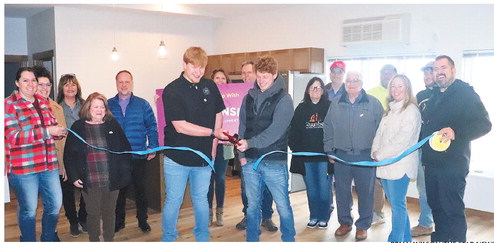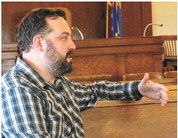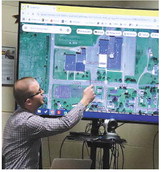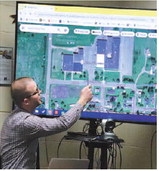Stetsonville OKs sewer plan with city


Faced with having to rebuild its 25 year-old sewer plant to meet new regulatory requirements, the village of Stetsonville is moving forward with a plan to send its waste up the road to Medford.
The city of Medford wastewater utility has the capacity to take on the additional waste volume without the need for significant plant changes. The biggest cost will be the construction of an approximately 4.5 mile pressurized force main that will connect the village’s sewer collection system to the city at a point on CTH O where it will then join with city waste going to the treatment plant on Whelen Ave.
While the price tag for the total project is about $5.7 million, various programs and principle forgiveness programs through the state will bring the cost to about $1.6 million dollars for the project. According to Nate Nickerson and Dylan Friss of Short Elliot Hendrickson (SEH) Engineering, there is also the potential the village could apply for and receive a community development block grant (CDBG) which could reduce the cost to rate payers to about $600,000. However Nickerson cautioned that the CDBG is competitive and there is no guarantee the village will be successful in getting it.
Representatives from SEH were at Monday’s village board meeting for a public hearing on the proposed project and a presentation of alternatives if the village decided to go a different direction.
The existing village of Stetsonville sewer treatment plant is a lagoon system designed primarily to treat for and remove organic waste and ammonia from the discharge water. However, since it was built, the state has increased regulation and the materials that need to be treated and removed from waste including phosphorus which used to be a common ingredient in detergents. With the village discharging treated water from the plant into the headwaters of the Big Eau Pleine Flowage, the village faces additional regulations.
The village is currently operating the sewer treatment under a variance which is set to expire, but which will be renewed as the project moves forward Of the options presented by the engineers, they said the least expensive one for the village is to go with the regionalization with the city of Medford.
Based on the current 2.5% interest rate in the clean water program, the engineers projected the average cost per customer at $1,220 per year, or about $305 per quarter.
Alternate proposals included adding onto the existing plant and covering the lagoons to allow for chemical and biological treatment for phosphorus removal. This could also include additional filtration of solids since phosphorus can bind to solids. “The idea concept is if there’s less solids there is less phosphorus,” Friss said.
A variation of this plan would include optimizing the lagoon system to be an algae-based system to remove phosphorus biologically. The benefit of this is that it would be the least amount of construction and less concrete. Friss noted that concrete is expensive. They estimated the cost of this option at being between $1,600 and $1,800 per year for the average rate payer in the village.
Describing the second alternative as being “just crazy and fun” the engineers looked at the possibility of a fullymechanical plant with steel tanks. This quickly proved to be prohibitively expensive at about a $2,600 per year cost to rate payers.
By far, the most economical option for the village, the engineers said, would be the regionalization plan with the city of Medford. This would involve the force main from a lift station in Stetsonville to a lift station on CTH O to connect with the Medford system.
On the city side, the city of Medford would send a bill to the village of Stetsonville for the total volume of waste pumped in the Medford system. The village would continue to be responsible for maintaining its existing sewer main system. It would continue to bill customers for sewer use, based on water usage rates.
Friss noted a benefit of connecting with Medford is that it will open the project to receiving additional regionalization funding since the state is encouraging regionalization of sewer systems. If the village is successful in getting the CDBG, the engineers projected that the rate could end up being similar to what sewer customers in the village are currently paying.
Village president Greg Brunner asked about the rates going forward that would be charged by the city. City coordinator Joe Harris said the city would charge the same rates to the village that they charge to the city of Medford users.
Waste water superintendent Alex Zenner noted there could be increases to rates over time, but that any increases would be for the city as well.
“We are just trying to be fair to the village of Stetsonville,” Harris said, noting they would put assurances into the contract language with the village for a 20-year agreement.
He cautioned that the village would still need to maintain its own sewer system reserves as required by the clean water funding and keep up maintenance on the village’s sewer mains. “The DNR wants you to keep money in the piggy bank,” he said.
Brunner expressed relief at the assurance from the city on treatment costs. He said beyond the cost savings of the regionalization option when compared to the alternatives, there is a benefit to the village from “getting away from the the DNR thumbprint.”
He noted that it seemed the DNR was regularly coming up with something new that had to be done and that nothing is cheap. He also noted that without the funding coming in, the village would not be able to go ahead with the project.
During the village board portion of the meeting, board members formally approved the plan to go ahead with the regionalization option and connect with the city of Medford wastewater system.
The action allows the engineers to begin work on submitting the plans to the state for approval and doing additional work. It will take several months for plan approvals and grant applications to be completed.
In other business, board members:
• Received an update from village building inspector Bob Christensen on property complaints in the village. He said he has spoken to several of the property owners and some projects are underway. He said that under the village’s existing codes he can only go so far in enforcement. He told board members that while he can, and does, send letters to residents about the state of their property and the need to comply with the village codes, he does not have the authority to issue citations if the property owners refuse to comply. He said in communities with a police department, the police can issue the citation to enforce the ordinances. He said the sheriff’s department will not enforce municipal ordinances for the village.
According to Christensen, if the village gives someone the authority to issue citations, the offending property owner would then be able to be prosecuted by the village’s attorney with the village able to recover costs through the court system.
Christensen said there also needs to be some leeway in enforcement about was is a major concern and what is not. “Is a stack of pallets a big deal?” Christensen said he did not see it as being as big a deal as having excess unregistered cars or broken windows. He said the village of Rib Lake is also facing this same issue and is working on an ordinance to give citation authority to someone. He said he is involved in that process in Rib Lake and offered his help to the village to work on their ordinance change. He said he hopes to have something to bring to the August 11 board meeting.
• Heard from library board president Beth Wesle about issues between the village and the library, in particular a recent service bill for the library’s heating ventilation and air conditioning (HVAC). She said the service was done without the knowledge or direction of the library. She noted the agreement between the library and the village puts library maintenance as the library’s responsibility. She expressed concerns about the cost of building maintenance and that the funds from the village are being used to keep the library running, but they do not have enough for major maintenance work. She said she would love to meet with board members and get on the same page as far as addressing maintenance needs at the library.
• Heard from resident Marsha Duellman about a closed session held at last month’s meeting. She said the meeting was not posted to go into closed session. Brunner said they were discussing workers wages and felt it belonged in closed session. Wisconsin open meetings laws allow for closed session for things like personnel matters, collective bargaining, and buying and selling property, but the meetings must be posted with the exception to the open meeting laws being used. Brunner apologized to Duellman for not having it posted properly and noted that future agendas will include if they will be planning to go into closed session.
• Clarified that the American Legion will get picnic licenses for the sale of beer at the ballfield at a cost of $10 per time rather than getting a class B permit. The cost to the Legion will be about the same as the cost of the license, but would not require the Legion to get a sellers permit.
• Received word from Brunner that going forward if citizens want to address the board on an item, they will need to let the village know in advance what the topic is they plan to talk about. He said this will allow the board members to have an idea of what is being brought so that they are prepared and can address the concern.
• Approved hiring Al Riemer to replace the existing garage door on the shop from one that is 9 feet wide to one that is 10 feet wide and 8 feet tall. This will allow for easier access by the village crew. They also approved garage door work, windows and insulation to be added to the cold storage building. The total cost with labor and materials for both is $41,658.40. Brunner noted that they are separate projects and the village will be purchasing the materials themselves and only paying the contractor to do the work. This will keep the projects under the $25,000 requirement to be put out for bid. Brunner noted his preference for purchasing the needed materials through Stetsonville Lumber since they are a taxpayer in the community. It was noted that the village has need of the space in the buildings and remodeling them is a cheaper option than building something new or adding onto the existing shop.
• Discussed the potential to raise the per bag cost for garbage in the village. The village currently charges $3 per kitchen bag or $5 per 55-gallon trash can. While the village currently has a slight positive balance, the clerk noted the village lost money on it last month. It was suggested to increase the cost to $4 per bag and $6 per trash can. It will be put on the August meeting agenda for additional discussion and possible action.






